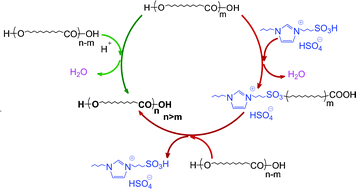Influence of Brønsted acid ionic liquid structure on hydroxyacid polyesterification
Abstract
Brønsted acid

* Corresponding authors
a
UPMC Univ Paris 06, UMR 7610, Laboratoire de Chimie des Polymères, Paris, France
E-mail:
alain.fradet@upmc.fr
Fax: 0033 144277054
Tel: 0033 144273738
b CNRS, UMR 7610, Laboratoire de Chimie des Polymères, Paris, France
Brønsted acid

 Please wait while we load your content...
Something went wrong. Try again?
Please wait while we load your content...
Something went wrong. Try again?
S. Zhang, H. Lefebvre, M. Tessier and A. Fradet, Green Chem., 2011, 13, 2786 DOI: 10.1039/C1GC15241F
To request permission to reproduce material from this article, please go to the Copyright Clearance Center request page.
If you are an author contributing to an RSC publication, you do not need to request permission provided correct acknowledgement is given.
If you are the author of this article, you do not need to request permission to reproduce figures and diagrams provided correct acknowledgement is given. If you want to reproduce the whole article in a third-party publication (excluding your thesis/dissertation for which permission is not required) please go to the Copyright Clearance Center request page.
Read more about how to correctly acknowledge RSC content.
 Fetching data from CrossRef.
Fetching data from CrossRef.
This may take some time to load.
Loading related content
